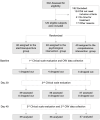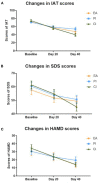Effects of Electroacupuncture Combined With Psychological Intervention on Depressive Status and Contingent Negative Variation in Patients With Internet Addiction Disorder: A Randomized Controlled Trial
- PMID: 34867514
- PMCID: PMC8634147
- DOI: 10.3389/fpsyt.2021.722422
Effects of Electroacupuncture Combined With Psychological Intervention on Depressive Status and Contingent Negative Variation in Patients With Internet Addiction Disorder: A Randomized Controlled Trial
Abstract
Background: Depressive symptoms often accompany people with Internet addiction syndrome (IAD). Acupuncture has been found to have significant advantages in improving the severity and depressive symptoms of IAD. Contingent negative variation (CNV) is a common method to explore the mechanism of neurophysiology. Objective: The purpose of this study was to observe the efficacy of electroacupuncture (EA), psychological intervention (PI), and comprehensive intervention (CI) in the treatment of depression in Internet addiction disorder (IAD), and to observe the changes of contingent negative variation (CNV) in each group. Methods: One hundred and twenty subjects diagnosed with IAD were randomly assigned to the EA group, the PI group, or the CI group. They received EA, PI, or a combination of EA and PI for 40 days. The Internet Addiction Test (IAT), the Zung Self-rating Depression Scale (SDS), and the Hamilton Depression Scale (HAMD) were evaluated for all subjects at baseline, 20th, and 40th days of treatment, while CNV data were collected at baseline and 40th days of treatment. Results: Three treatments effectively reduced IAT, SDS, and HAMD scores, and the intergroup comparison showed that CI was superior to EA, while EA was superior to PI. CNV results indicated that the CNV amplitude increased in all three groups of IAD patients after treatment. The CNV latency of point A and A-S2' wave area of the EA group and the CI group did not change significantly after treatment. Only the A-S2' wave area of the PI group increased significantly compared with the baseline period. In addition, IAD's IAT score was positively correlated with SDS and HAMD score at baseline but negatively correlated with CNV latency. After treatment, only the change of HAMD score in the CI group was negatively correlated with amplitude. Conclusion: Our results demonstrate the efficacy of acupuncture and psychological intervention in the treatment of IAD from an electrophysiological perspective. Simultaneously, the increase in CNV amplitude might be the underlying neurophysiological mechanism by which CI improves depression and cognitive function in IAD patients. Clinical Trial Registration: ClinicalTrials.gov, identifier NCT02362698.
Keywords: acupuncture; cognitive-behavioral therapy; contingent negative variation; depression; internet addiction disorder; psychological intervention.
Copyright © 2021 Peng, Wang, Hao, Wang, Chen, Qiu, Tu, Li and Zhu.
Conflict of interest statement
The authors declare that the research was conducted in the absence of any commercial or financial relationships that could be construed as a potential conflict of interest.
Figures




Similar articles
-
Effect of electro-acupuncture combined with psychological intervention on mental symptoms and P50 of auditory evoked potential in patients with internet addiction disorder.J Tradit Chin Med. 2017 Feb;37(1):43-8. doi: 10.1016/s0254-6272(17)30025-0. J Tradit Chin Med. 2017. PMID: 29956903 Clinical Trial.
-
The modulation of mRNA levels of MAOA by electroacupuncture and psychotherapy in patients with pathological internet use.Front Psychiatry. 2022 Aug 11;13:918729. doi: 10.3389/fpsyt.2022.918729. eCollection 2022. Front Psychiatry. 2022. PMID: 36032227 Free PMC article.
-
[Clinical effect of electroacupuncture combined with psychologic interference on patient with Internet addiction disorder].Zhongguo Zhong Xi Yi Jie He Za Zhi. 2009 Mar;29(3):212-4. Zhongguo Zhong Xi Yi Jie He Za Zhi. 2009. PMID: 19548435 Clinical Trial. Chinese.
-
Electroencephalography-detected neurophysiology of internet addiction disorder and internet gaming disorder in adolescents - A review.Med J Malaysia. 2021 May;76(3):401-413. Med J Malaysia. 2021. PMID: 34031341 Review.
-
Clinical effects and safety of electroacupuncture for the treatment of post-stroke depression: a systematic review and meta-analysis of randomised controlled trials.Acupunct Med. 2018 Oct;36(5):284-293. doi: 10.1136/acupmed-2016-011300. Epub 2018 May 18. Acupunct Med. 2018. PMID: 29776950
Cited by
-
Effects of different interventions on internet addiction: a systematic review and network meta-analysis.BMC Psychiatry. 2023 Dec 8;23(1):921. doi: 10.1186/s12888-023-05400-9. BMC Psychiatry. 2023. PMID: 38066462 Free PMC article.
-
Recent treatment and novel imaging studies evaluating treatment of internet gaming disorder: a narrative review.Front Psychiatry. 2024 Jun 13;15:1408560. doi: 10.3389/fpsyt.2024.1408560. eCollection 2024. Front Psychiatry. 2024. PMID: 38938461 Free PMC article. Review.
References
-
- Young KS. Internet addiction - A new clinical phenomenon and its consequences. Am Behav Sci. (2004) 48:402–15. 10.1177/0002764204270278 - DOI
Associated data
LinkOut - more resources
Full Text Sources
Medical
Research Materials
Miscellaneous

